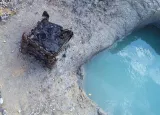Published: 28.01.2019
A seven thousand years old well – the oldest well found in the Czech Republic and the oldest wooden architectural structure in Europe – is to be preserved by the experts of the University of Pardubice. The unique discovery was made by archaeologists last year at Ostrov in the Pardubice Region where, during the construction of the D35, they uncovered another seven wells from different prehistoric times.
The parts of the well are now stored in the cellars of the Piarist College in Litomyšl with suitable climatic conditions, where preservation works are also planned. “Boards” from the timbering are stored in water in black plastic containers while the poles that were in the corners of the well are placed in plastic pipes.
"It is by far the oldest object that we will be working on at the faculty, and it will not be an easy task. But our experience entitles us to carry out the preservation," said Karol Bayer, Vice-Dean of the Faculty of Restoration, University of Pardubice.
It was only preserved because it stayed underwater
At present, preparatory work of the preservation of found wooden parts of the well – posts and boards – is taking place at the Faculty. “The well was only preserved because it had been underwater for centuries. Now we cannot let it dry out, or the well would be destroyed. That is why we will gradually replace the water with a new preservative that each of us knows and uses. It is saccharose. So we will increase the concentration of the sugar solution,” Bayer added.
The process, which will allow the preservation of wooden elements without their deformation after drying, is being prepared by the experts from the Faculty of Restoration in cooperation with the Department of Chemical Technology of Monument Conservation of UCT Prague. The entire process will take several months.
Hoisting the well was technically challenging
The first findings of pottery have shown that the well at Ostrov comes from a period of linear pottery culture, that is from the Neolithic. Thanks to this unique discovery, it was decided to hoist the entire well in one block. "This operation took place in cooperation with Samson Praha and was a technically and logistically demanding task the kind of which was the first ever in the Czech Republic. It was followed by a meticulous preparation of the individual layers and disassembly of the wooden structure. More than a month of work on the archaeological site has brought unique findings," said research leader, Radko Sedlacek of the Olomouc Archaeological Centre.
The structure of the well consisted of four corner posts with longitudinal grooves at an angle of 90 degrees. The boards were recessed in seven rows above one another. Ground plan dimensions of the well were 80x80 centimetres, and the total height reached 140 centimetres. All the structural parts were of oak.
Experts dated the age of wood over 7000 years
"In case of the well found in Chrudim, we discussed the annual rings with our colleagues in Germany. The results show that the trees used to build the well were cut down between 5256–5255 BC. It is interesting that the corner posts were made of previously felled trunks, namely from the trunk which had been cut in the autumn or winter 5259 BC or the winter of early 5258 BC," said Michal Rybníček from the Department of Wood Science of the Faculty of Forestry and Wood Technology, Mendel University, Brno.
According to experts, it is admirable that the first farmers, who only had tools made of stone, bone, horn, or wood, were able to process the surface of felled trunks with utmost precision. “This is evidenced by the shape of the individual constructional components and the traces of tools on the surface of the wood. It is also worth mentioning that the individual trunks used to make the constructional parts of the well had to reach a minimum diameter of about 60 cm," added Rybníček.
Detailed analyses of the animals and plants from the well
Experts also carried out the first scientific analyses. What they found in the fill of the well were the residues of large numbers of invertebrate animals and small vertebrates, mainly shellfish, small vertebrate bones, overwintering crustacean eggs, and insect residues. The discovery of zoological remains will chiefly make it possible to reconstruct the environment of the Neolithic.
There is also a rich set of plant remains. "Human activities around the well, as documented by botanical analyses, are in contrast to the smaller number of archaeological finds from the fill, which can probably be explained by the location of the well beyond its neolithic settlement," said Petr Kočár from the Olomouc Archaeological Centre.
The first results of archaeobotanical analyses provide information on the environment and the economy of the first farmers. For example, so far identified were residues of crop plant species, including prehistoric wheat, flax, or rarely evidenced opium poppy. Wild plant species will enable a better understanding of first farmers’ activities and reconstructing the history of the introduction of non-native species by man.
For more information on the Neolithic well, contact
Ing. Karol Bayer
Vice-Dean of the Faculty of Restoration, University of Pardubice
Email karol.bayer@upce.cz
Phone +420 466 036 602

